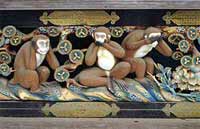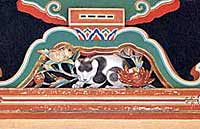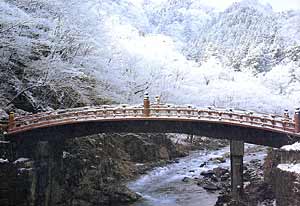| World Heritage
- Shrines and Temples of Nikko - |
| Introduction |
| “Shrines and Temples of Nikko” were registered as World Heritage site at the 23rd session of the UNESCO World Heritage Committee held at Marakesh in Morocco in December 1999. The site consists of two Shinto shrines (Futarasan Shrine, Toshogu Shrine) and Buddhist temple (Rinnoji Temple). There are 103 historical buildings consisting of 9 national treasures and 94 important cultural properties. Most of the buildings were constructed by the greatest artists in the 17th century, and their artistic values are very high. Also, Nikko played an important role in supporting political structure of Edo period. For example, successive shoguns, envoys dispatched from imperial court in Kyoto, diplomatic envoys from Korea, they visited to Nikko. Moreover, those buildings are well harmonized with natural environment in order to take place for religious activities to worship mountains of Nikko. |
| Toshogu Shrine | ||
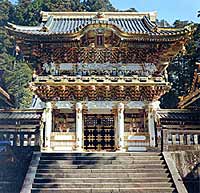 Toshogu
was originally constructed in 1617, a year after Ieyasu Tokugawa died. The reason
why Toshogu was erected in Nikko, was because directional relationship with Edo.
Nikko is located in the north of Edo. Ieyasu defined Nikko as the center of Edo
(or whole nation) by referring the relationship between the polestar and universe.
His intention was to protect the whole nation by being the polestar of Edo. Although
Toshogu was constructed in a small sized and simple shrine as Ieyasu’s last
will, the shrine was reconstructed and expanded to larger size and became more
gorgeous in color in 1636. Toshogu
was originally constructed in 1617, a year after Ieyasu Tokugawa died. The reason
why Toshogu was erected in Nikko, was because directional relationship with Edo.
Nikko is located in the north of Edo. Ieyasu defined Nikko as the center of Edo
(or whole nation) by referring the relationship between the polestar and universe.
His intention was to protect the whole nation by being the polestar of Edo. Although
Toshogu was constructed in a small sized and simple shrine as Ieyasu’s last
will, the shrine was reconstructed and expanded to larger size and became more
gorgeous in color in 1636. |
||
| Events and Heritages There are 8 national treasures and 32 important cultural properties in Toshogu. Also, seven annual events have been taken there. Some examples are as follows: •Procession of a Thousand Warriors [May 17th to 18th, October 17th] •The Gojuunoto (Five storied pagoda) •The Omizuya •The Shinkyu (Sacred Horse Stable) •The Sansaru (Three Monkeys) •The Yomeimon Gate (Sunlight Gate) •The Shourou, Korou, Honzi-do (Belfry and Drum Tower, Honzi-do hall) •The Nakiryu (Crying Dragon) •The Nemurineko (Sleeping Cat)
|
| Rinnoji Temple |
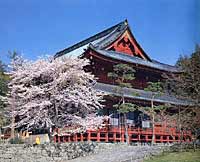 Rinnoji
Temple is a generic term for temples, shrines, and 15 subordinative temples. The
site thrived as a place for mountain worship and many Buddhist ascetics visited
to practice since the priest Shoto constructed Shihonryuji Temple in the end of
the 8th century. Rinnoji
Temple is a generic term for temples, shrines, and 15 subordinative temples. The
site thrived as a place for mountain worship and many Buddhist ascetics visited
to practice since the priest Shoto constructed Shihonryuji Temple in the end of
the 8th century. |
| Events and Heritages There are 37 important cultural properties and a national treasure in Rinnoji Temple. Also, 15 annual events have been taken there. Some examples are as follows: •Takigino (Noh plays) [Friday and Saturday around August 20th ] •Compulsory Rice Eating Ceremony [April 2nd] •The bronze statue of the priest Shoto |
| Futarasan Shrine | |
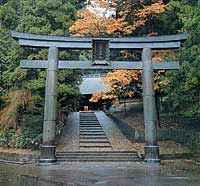 Futarasan
Shrine has been the center of mountain worship since ancient period. A priest
Shoto constructed Shihonryuji Temple on the north side of the Daiya River in 766
and constructed Hongu Shrine (Main shrine) then. This was the beginning of Futarasan
Shrine. The Futarasan Shrine had been respected as the best shrine of Tochigi
prefecture since early times, and worshiped by shogunate and powerful clan as
the guardian of Kanto region. Tokugawa shogunate constructed more shrines and
contributed sacred territory when Toshogu Shrine was built in 1617 to express
respect for the Futarasan shrine. Futarasan
Shrine has been the center of mountain worship since ancient period. A priest
Shoto constructed Shihonryuji Temple on the north side of the Daiya River in 766
and constructed Hongu Shrine (Main shrine) then. This was the beginning of Futarasan
Shrine. The Futarasan Shrine had been respected as the best shrine of Tochigi
prefecture since early times, and worshiped by shogunate and powerful clan as
the guardian of Kanto region. Tokugawa shogunate constructed more shrines and
contributed sacred territory when Toshogu Shrine was built in 1617 to express
respect for the Futarasan shrine. |
|
| Events and Heritages There are 23 important cultural properties in Futarasan Shrine. Also, 22 annual events have been taken there. Some examples are as follows: •Yayoi Festival [April 13th to 17th] •The Shinkyo (Sacred Bridge)
|
Nikko Hot spa, Johsyu-ya Inn
Postal code: 321-1402
Nakahatsuishi 911, Nikko, Tochigi, Japan
TEL: 81-288-54-0155 FAX: 81-288-53-2000
